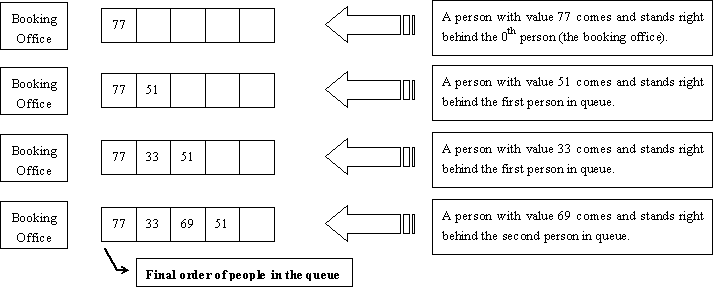【poj2828】Buy Tickets
Railway tickets were difficult to buy around the Lunar New Year in China, so we must get up early and join a long queue…
The Lunar New Year was approaching, but unluckily the Little Cat still had schedules going here and there. Now, he had to travel by train to Mianyang, Sichuan Province for the winter camp selection of the national team of Olympiad in Informatics.
It was one o’clock a.m. and dark outside. Chill wind from the northwest did not scare off the people in the queue. The cold night gave the Little Cat a shiver. Why not find a problem to think about? That was none the less better than freezing to death!
People kept jumping the queue. Since it was too dark around, such moves would not be discovered even by the people adjacent to the queue-jumpers. “If every person in the queue is assigned an integral value and all the information about those who have jumped the queue and where they stand after queue-jumping is given, can I find out the final order of people in the queue?” Thought the Little Cat.
Input
There will be several test cases in the input. Each test case consists of N + 1 lines where N (1 ≤ N ≤ 200,000) is given in the first line of the test case. The next N lines contain the pairs of values Posi and Valiin the increasing order of i (1 ≤ i ≤ N). For each i, the ranges and meanings of Posi and Vali are as follows:
- Posi ∈ [0, i − 1] — The i-th person came to the queue and stood right behind the Posi-th person in the queue. The booking office was considered the 0th person and the person at the front of the queue was considered the first person in the queue.
- Vali ∈ [0, 32767] — The i-th person was assigned the value Vali.
There no blank lines between test cases. Proceed to the end of input.
Output
For each test cases, output a single line of space-separated integers which are the values of people in the order they stand in the queue.
Sample Input
4
0 77
1 51
1 33
2 69
4
0 20523
1 19243
1 3890
0 31492
Sample Output
77 33 69 51
31492 20523 3890 19243
Hint
The figure below shows how the Little Cat found out the final order of people in the queue described in the first test case of the sample input.

Source
#include <iostream>
#include <cstdio>
#include <cmath>
#define MAXN 200000
using namespace std;
int segtree[MAXN*],a[MAXN],b[MAXN],c[MAXN];
int n;
void adddata(int now)
{
segtree[now]=segtree[(now<<)]+segtree[(now<<)+];
}
void buildtree(int now,int l,int r)
{
if (l==r) {segtree[now]=; return;}
int mid=(l+r)>>;
buildtree((now<<),l,mid);
buildtree((now<<)+,mid+,r);
adddata(now);
}
int query(int now,int l,int r,int v)
{
if (l==r) {segtree[now]=; return l;}
int mid=(l+r)>>,ans;
if (v<=segtree[(now<<)]) ans=query((now<<),l,mid,v);
else ans=query((now<<)+,mid+,r,v-segtree[(now<<)]);
adddata(now);
return ans;
}
int main()
{
int i,pos;
while (~scanf("%d",&n))
{
for (i=;i<=n;i++) scanf("%d%d",&a[i],&b[i]);
buildtree(,,n);
for (i=n;i>=;i--)
{
pos=query(,,n,a[i]+);
c[pos]=b[i];
}
for (i=;i<n;i++) printf("%d ",c[i]);
printf("%d\n",c[n]);
}
return ;
}
【poj2828】Buy Tickets的更多相关文章
- 【poj2828】Buy Tickets 线段树 插队问题
[poj2828]Buy Tickets Description Railway tickets were difficult to buy around the Lunar New Year in ...
- 【POJ2828】Buy Tickets(线段树)
题意:有一个输入序列,每次操作要把b[i]插入到第a[i]个,在第a[i]个后面的要后移,问最后序列. n<=200000 思路:顺序来只能用splay维护 考虑倒序,对于插入到第K个位置,在线 ...
- 【插队问题-线段树-思维巧妙】【poj2828】Buy Tickets
可耻的看了题解 巧妙的思维 逆序插入,pos 代表的意义为前面要有pos个空格才OK: 证明:仔细思考一下就觉得是正确的,但是要想到这种方式还是要很聪明,空格是前面的几个数字所形成的,所以要特地留出来 ...
- 【POJ】Buy Tickets(线段树)
点更新用法很巧妙的一道题.倒序很容易的找到该人的位置,而update操作中需要不断的变化下标才能合理的插入.看了别人写的代码,学习了. #include <iostream> #inclu ...
- 【CF865D】Buy Low Sell High(贪心)
[CF865D]Buy Low Sell High(贪心) 题面 洛谷 CF 题解 首先有一个\(O(n^2)\)的\(dp\)很显然,设\(f[i][j]\)表示前\(i\)天手中还有\(j\)股股 ...
- 【BZOJ4375】Selling Tickets 随机化
[BZOJ4375]Selling Tickets Description 厨师在一次晚宴上准备了n道丰盛的菜肴,来自世界各地的m位顾客想要购买宴会的门票.每一位顾客都有两道特别喜爱的菜,而只要吃到了 ...
- 【POJ 2828】Buy Tickets
[题目链接] http://poj.org/problem?id=2828 [算法] 离线用线段树维护序列即可 [代码] #include <algorithm> #include < ...
- 【hdoj_1133】Buy the Ticket(卡特兰数+大数)
题目:http://acm.hdu.edu.cn/showproblem.php?pid=1133 题目的意思是,m个人只有50元钱,n个人只有100元整钱,票价50元/人.现在售票厅没钱,只有50元 ...
- 【高精度练习+卡特兰数】【Uva1133】Buy the Ticket
Buy the Ticket Time Limit: 2000/1000 MS (Java/Others) Memory Limit: 65536/32768 K (Java/Others) T ...
随机推荐
- Linux 下 Console / 控制台 复制粘贴快捷键
Linux下复制粘贴快捷键 1. 在终端下: 复制命令:Ctrl + Shift + C 组合键. 粘贴命令:Ctrl + Shift + V 组合键. 2. 在控制台下: 复制命令:Ctrl + ...
- python 之socket 网络编程
socket通常也称作"套接字",用于描述IP地址和端口,是一个通信链的句柄,应用程序通常通过"套接字"向网络发出请求或者应答网络请求. socket起源于Un ...
- Linux环境下stl库使用(map)
例子1: testMap.cpp #include <string.h> #include <iostream> #include <map> #include & ...
- android 入门-生命周期 activity
生命周期 activity http://blog.csdn.net/android_tutor/article/details/5772285 http://www.cnblogs.com/John ...
- 在ASP.NET Core 1.0中如何发送邮件
(此文章同时发表在本人微信公众号"dotNET每日精华文章",欢迎右边二维码来关注.) 题记:目前.NET Core 1.0中并没有提供SMTP相关的类库,那么要如何从ASP.NE ...
- ios编码转换 国标 UTF-8
我们知道,使用NSURLConnection的代理方法下载网页,存到一个NSData中, NSMutableData *pageData; [pageData appendData:data]; 如果 ...
- LaTex学习笔记(一)
1. 语法 命令 普通命令 环境 数据 注释 2. 物理结构 导言 指定文档类型,引入宏包,定义命令,环境等 \documentclass[options]{class} \usepackage[op ...
- Linux学习笔记(10)文本编辑器vim
vim是一个功能强大的全屏幕文本编辑器,是Linux/Unix最常用的文本编辑器,其作用是建立.编辑.显示文本文件.vim的特点是没有菜单,只有命令. vim主要有三种工作模式,分别为命令模式.插入模 ...
- 全面解析windows下Memcache技术应用
原文 http://www.cnblogs.com/liuqin520/p/4615644.html 一.Memcache介绍 Memcache 是 danga.com 的一个项目,最早是为 L ...
- zookeeper源码分析二FASTLEADER选举算法
如何在zookeeper集群中选举出一个leader,zookeeper使用了三种算法,具体使用哪种算法,在配置文件中是可以配置的,对应的配置项是"electionAlg",其中1 ...
